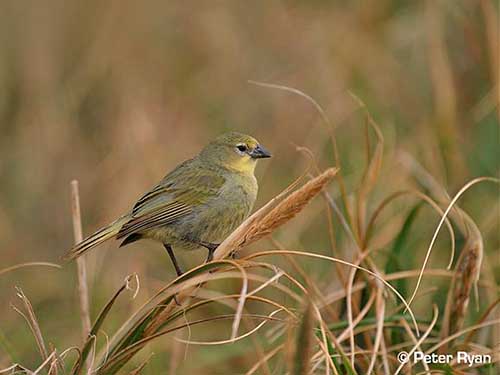
Fr: Nésospize acunha – Nésospize de Tristan da Cunha
Ang: Inaccessible Island Finch
All: Tristanammerfink
Esp: Yal de la Inaccesible
Ita: Fringuello dell'Isola Nightingale
Nd: Inaccessiblegors
Sd: Tristanfink
Photographers:
Otto Plantema
Trips around the world
Peter Ryan
The Percy Fitzpatrick Institute of African Ornithology
Alan & Ann Tate
AA Bird Photography
Text by Nicole Bouglouan
Sources:
HANDBOOK OF THE BIRDS OF THE WORLD Vol 16 by Josep del Hoyo- Andrew Elliot-David Christie – Lynx Edicions – ISBN: 9788496553781
HBW Alive
Molecular Phylogenetics and Evolution – The origin of finches on Tristan da Cunha and Gough island, central South Atlantic Ocean
Peter G. Ryan, Luke B. Klicka, Keith F. Barker, Kevin J. Burns
SORA Searchable Ornithological Research Archive (Blair O. Wolf)
Color variation and Hybridization among Nesospiza buntings on Inaccessible Island, Tristan da Cunha
Peter G. Ryan, Coleen L. Moloney and Jocelyn Hudon
Bio One - Online Journals - Research Evolved
Morphological heritability in a hybrid bunting complex: Nesospiza at Inaccessible Island
Peter G. Ryan
SCIENCE/AAAS
Ecological Speciation in South Atlantic Island Finches
Peter G. Ryan, Paulette Bloomer, Coleen L. Moloney, Tyron J. Grant and Wayne Delport
BirdLife International (BirdLife International)
Red List of Threatened species
Inaccessible Island Finch
Nesospiza acunhae
Passeriformes Order – Thraupidae Family
INTRODUCTION:
The Inaccessible Island Finch is endemic to this island, part of the Tristan da Cunha group in South Atlantic Ocean. This species is widespread on the small island (13 Km²) where three subspecies are living and interbreeding. The three finches have different bill sizes, closely related to their diet including small to large seeds and fruits according to the habitat types.
The nominate race was formerly present on the main island of Tristan da Cunha, but this population disappeared with the settlement, probably due to predation by introduced House Mouse (Mus musculus) and feral cats.
On Inaccessible Island, the population remains vulnerable to accidental introduction of invasive species. The habitat is also threatened by the invasive introduced New Zealand flax (Phormium tenax) into the Plylica arborea areas, leading to habitat degradation. However, actions are under way to eradicate this plant and the risk is now reduced.
DESCRIPTION OF THE BIRD:
Biometrics:
Length: 17-21 cm
Weight: 24-49 gr
The adult male of nominate race has olive-green upperparts and paler olive-grey underparts. The flight feathers are dark olive-brown with yellowish outer webs.
On the head, forecrown and throat are yellowish. The lores and a broad feathered eyering are pale grey.
The conical bill is dark grey to blackish. The eyes are dark brown. Legs and feet are blackish.
The female is slightly smaller than male. She has similar plumage but duller and usually more streaked above.
Juvenile and immature resemble adult female, but they are more heavily streaked.

SUBSPECIES AND RANGE:
Three subspecies are recognized on Inaccessible Island.
N.a. acunhae (described above) occurs in lowland and coastal rocky shores.
N.a. fraseri occurs on the Plateau between 300 and 600 metres of elevation.
This race has brighter green upperparts and yellow underparts, with larger head and longer wings and tarsi. But the bill is smaller than that of nominate.
N.a. dunnei is found on the coast and E Plateau.
This one is about 2/3 larger than acunhae and fraseri. The bill is much larger and deeper.
The three subspecies interbred in ecotone, between Blachnum heath and Plylica arborea woodland on the Plateau.
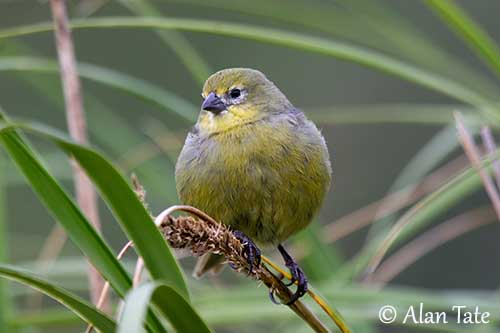
HABITAT:
The Inaccessible Island Finch of nominate race “acunhae” occurs in coastal lowlands and cliffs with tussock grassland.
The race “fraseri” occurs mainly on the Plateau, but some immatures can be seen feeding along the coasts in winter/spring.
The race “dunnei” frequents the tall Phylica arborea woodland where it can find abundant fruit sources.
CALLS AND SONGS:
The Inaccessible Island Finches, male and female, utter a chirping contact call, and louder alarm calls when a Brown Skua is flying above their territory.
The male’s song is a phrase of 3-4 notes “wit it teeu” often repeated.
The male “dunnei” utters deeper and slower song than other races, due to its larger bill.
Usually, the females utter soft, plaintive whistles.
BEHAVIOUR IN THE WILD:
The Inaccessible Island Finch feeds primarily on seeds, fruits and invertebrates.
The small-billed nominate race “acunhae” feeds on seeds and flowers of Spartina (family Poaceae) a native plant species, and seeds of other grasses and sedges (Carex). It also takes invertebrates such as flies (Diptera) found among seaweeds in intertidal zones.
The race “fraseri” feeds mainly on seeds of sedges, fruits of Nertera (family Rubiaceae) and also takes invertebrates. As its food includes more carotenoids due to dietary differences, its plumage is brighter than that of other races.
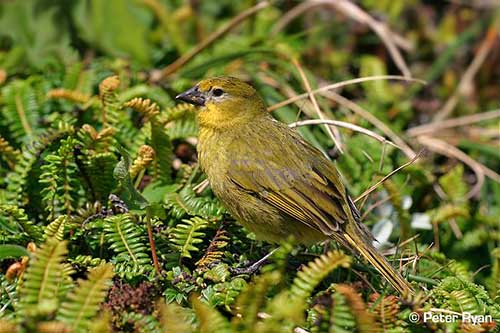
Race "fraseri"
Brighter plumage
The race “dunnei” and also the large-billed hybrids, feed mainly on Phylica fruit (family Rhamnaceae), but they feed on invertebrates too.
They forage from bark, foliage, lichens and flowers, to boulders and ground.
The Inaccessible Island Finches are usually monogamous. Both mates remain together for several breeding attempts.
From some observations, one male of nominate race “acunhae” with two females and a nest of race “dunnei” with possible helper have been reported.
Both sexes are territorial, chasing away the intruders from the territory. Most nest failures are caused by predation by the Tristan Thrush, but also by bad weather conditions. The race “dunnei” has much lower breeding success, possibly due to starvation.
The Inaccessible Island Finch is mostly resident. However, immature birds “fraseri” can be seen foraging along the coast in winter. They return in September/October to the Plateau.
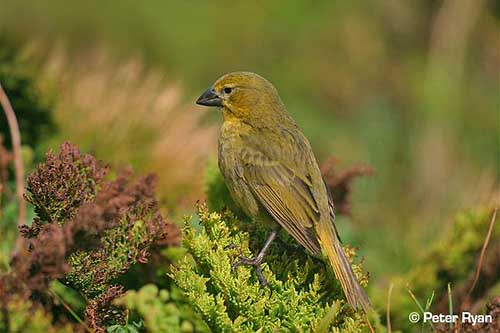
Race "dunnei"
Larger bill
REPRODUCTION OF THIS SPECIES:
The breeding season occurs between November and February. This species produces a single brood per season.
The female builds the cup-shaped nest with grass and sedge leaves. The nest is usually placed fairly close to the ground in thick vegetation. However, some nests can be found in Spartina tussock, up to 1-2 metres above the ground.
The female lays 1-2 pale blue eggs with fine dark brown markings. She incubates alone during 17-18 days, but the male feeds her during this period. After hatching, the chicks are brooded by the female during the first week. Then, male and female feed them with caterpillars and other invertebrates.
The young fledge about 18-21 days after hatching. They hide under the dense vegetal cover during several days, and then, they remain in family group during 5-6 weeks.
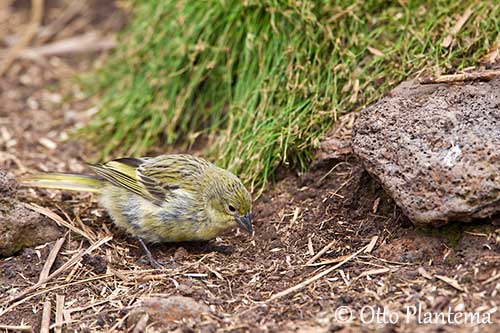
PROTECTION / THREATS / STATUS:
The Inaccessible Island Finch has restricted range on the small (13 km²) Inaccessible Island. This species is always threatened by accidental introduction of mammalian predators and degradation of the habitat by the invasive New Zealand flax (Phormium tenax). But control measures are under way and the risk is now reduced.
The race “dunnei” is vulnerable to reduction of fruit sources on Phylica trees, due to the introduction of scale bugs (sap-sucking insects) and associated sooty moulds (Ascomycete fungi) which destroy the plant and its fruits. The sooty mould usually follows an infestation by scale bugs.
The Inaccessible Island Finch is abundant on the island, and the total population is estimated at 23,400 mature individuals.
But currently, the species is classified as Vulnerable.
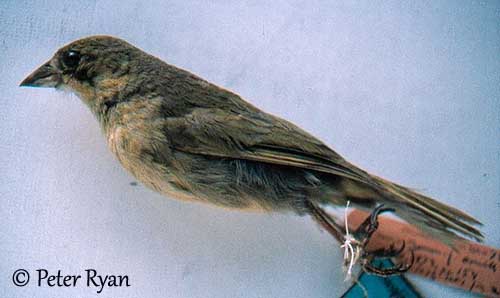
The nominate race was formerly present on the main island of Tristan da Cunha, but this population disappeared with the settlement, probably due to predation by introduced House Mouse (Mus musculus) and feral cats.
Picture of the only Tristan Bunting specimen in existence.